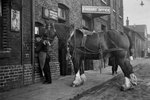Although the quarter horse and Tennessee walking horse are very different breeds, they have one important thing in common. Both are true American breeds, originally created for utilitarian purposes in the age of horse power. They both generally have good temperaments, making them suitable horses for novice equestrians.
Breed Histories
The American quarter horse traces his history back to the Colonial era. His ancestors include the Arabian, Barb and Turk. Later, the blood of mustangs was mixed in, giving the proto-quarter horse exceptional hardiness.
As the name implies, the Tennessee walking horse originated in Tennessee, the result of a combination of Canadian pacer, thoroughbred, Morgan, standardbred, saddlebred stock, as well as the now-extinct Narragansett pacer. Breeders were looking to create an exceptionally comfortable riding horse.
Breed Uses
While these horses were bred for distinctly different purposes, both make excellent trail mounts. The quarter horse is the epitome of the working ranch horse, but the Tennessee walker can also learn to do cutting and reining. Quarter horses are also bred for racing, but America's most popular breed is versatile enough to compete in almost any equine discipline.
The Tennessee walking horse is found in the show ring, but is still sought after by those seeking a comfortable ride. Because of the horse's smooth gaits, people with back problems who experience pain riding conventionally gaited horses can still enjoy riding the Tennessee walker.
Warnings
Some Tennessee walker show horses are subject to soring, a practice of applying caustic materials to the legs to make them perform an exaggerated gait. They are also shod with extremely large, padded shoes for the same effect. If you want to show Tennessee walkers, you don't have to go this route. Organizations supporting natural Tennessee walkers hold shows in which horses are shown in normal shoes and aren't exhibited to display exaggerated gaits.
Gait Differences
The quarter horse exhibits the standard gaits of most equines -- walk, trot, canter -- or lope, in Western horse lingo -- and gallop. The Tennessee walking horse is a gaited breed, naturally performing other smooth gaits for the ease of the rider. For walkers, the classic gait is the running walk, a lateral four-beat gait in which the horse may travel as much as 10 mph. In other breeds, a bobbing head is generally a sign of lameness. In the Tennessee walker, it means his head bobs in conjunction with his hoof's rhythm. Other gaits performed by the Tennessee walker include the pace, the rack, the singlefoot and the foxtrot -- although not every horse can perform every gait.
Breed Appearance
The quarter horse is generally a stocky, muscular animal. He is usually a medium-sized horse with good bone. The head is relatively short, with large eyes and a medium-length neck. Because the American Quarter Horse Association allows crosses with thoroughbreds, resulting in an "appendix" quarter horse, those with more thoroughbred blood may grow taller and appear more refined than the foundation type of quarter horse. The quarter horse may appear in any solid color.
The Tennessee walker is also usually of medium size, averaging about 15.2 hands, although much taller horses aren't uncommon. The head is large but refined, and the horse has sloping shoulder, a long neck and a short back. The walker appears in all solid colors, as well as pinto or paint.
Writer Bio
Jane Meggitt has been a writer for more than 20 years. In addition to reporting for a major newspaper chain, she has been published in "Horse News," "Suburban Classic," "Hoof Beats," "Equine Journal" and other publications. She has a Bachelor of Arts in English from New York University and an Associate of Arts from the American Academy of Dramatics Arts, New York City.




